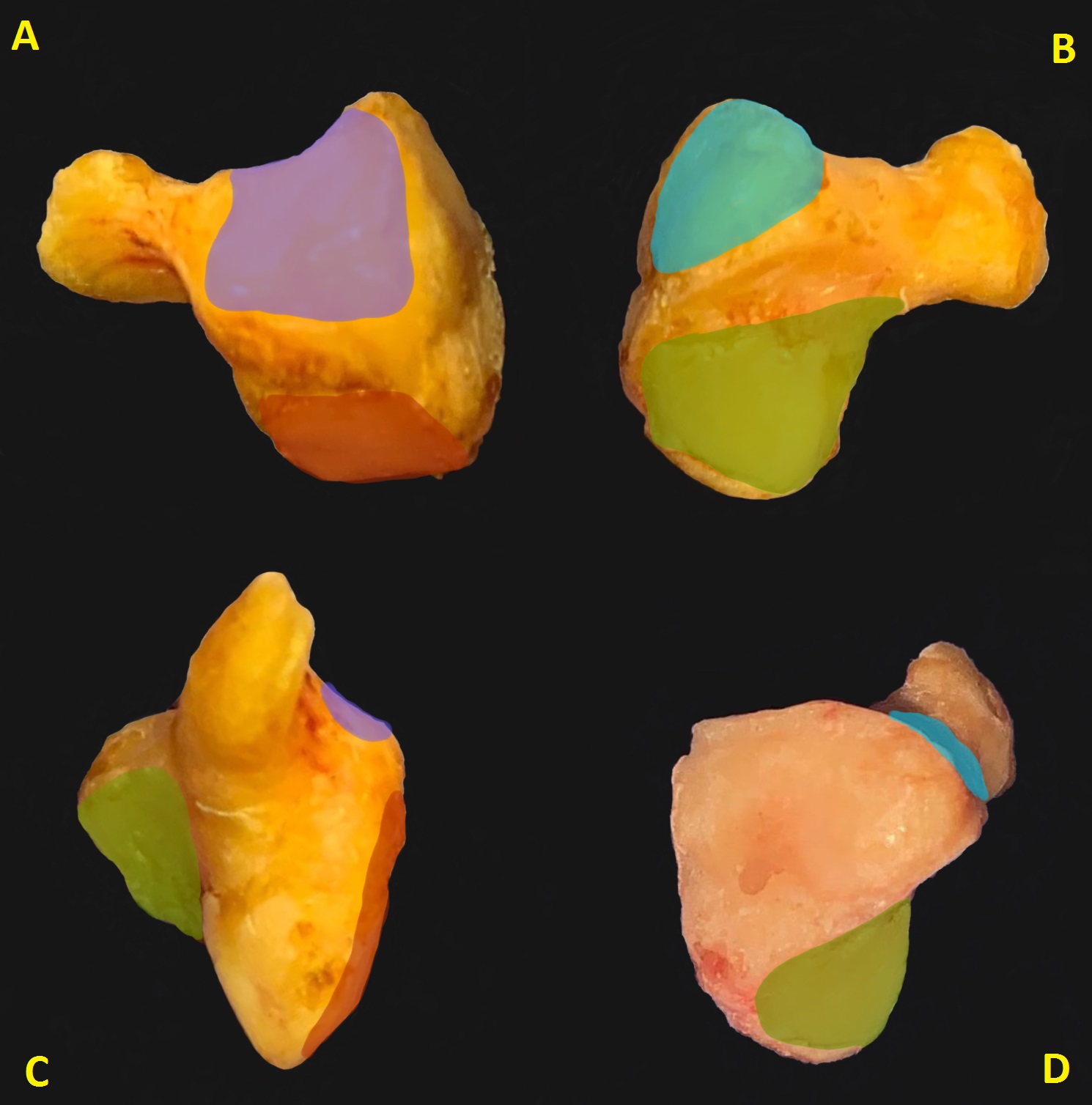[1]
Bishop AT, Beckenbaugh RD. Fracture of the hamate hook. The Journal of hand surgery. 1988 Jan:13(1):135-9
[PubMed PMID: 3351218]
[2]
Arora S, Goyal A, Mittal S, Singh A, Sural S, Dhal A. Combined intraarticular fracture of the body and the hook of hamate: an unusual injury pattern. Journal of hand and microsurgery. 2013 Dec:5(2):92-5. doi: 10.1007/s12593-012-0070-2. Epub 2012 Jun 14
[PubMed PMID: 24426686]
[3]
Hirano K, Inoue G. Classification and treatment of hamate fractures. Hand surgery : an international journal devoted to hand and upper limb surgery and related research : journal of the Asia-Pacific Federation of Societies for Surgery of the Hand. 2005:10(2-3):151-7
[PubMed PMID: 16568508]
[4]
Yalcinkaya M, Azar N, Dogan A. A rare wrist injury: simultaneous fractures of the hamate body and scaphoid waist. Orthopedics. 2009 Aug:32(8):. pii: orthosupersite.com/view.asp?rID=41930. doi: 10.3928/01477447-20090624-23. Epub
[PubMed PMID: 19708624]
[5]
Gella S, Borse V, Rutten E. Coronal fractures of the hamate: are they rare or rarely spotted? The Journal of hand surgery, European volume. 2007 Dec:32(6):721-2
[PubMed PMID: 17993445]
[6]
Aldridge JM 3rd, Mallon WJ. Hook of the hamate fractures in competitive golfers: results of treatment by excision of the fractured hook of the hamate. Orthopedics. 2003 Jul:26(7):717-9
[PubMed PMID: 12875568]
[7]
Boulas HJ, Milek MA. Hook of the hamate fractures. Diagnosis, treatment, and complications. Orthopaedic review. 1990 Jun:19(6):518-29
[PubMed PMID: 2367145]
[8]
Urch EY, Lee SK. Carpal fractures other than scaphoid. Clinics in sports medicine. 2015 Jan:34(1):51-67. doi: 10.1016/j.csm.2014.09.006. Epub 2014 Oct 11
[PubMed PMID: 25455396]
[9]
Devers BN, Douglas KC, Naik RD, Lee DH, Watson JT, Weikert DR. Outcomes of hook of hamate fracture excision in high-level amateur athletes. The Journal of hand surgery. 2013 Jan:38(1):72-6. doi: 10.1016/j.jhsa.2012.10.011. Epub 2012 Nov 30
[PubMed PMID: 23200952]
[10]
Bachoura A, Wroblewski A, Jacoby SM, Osterman AL, Culp RW. Hook of hamate fractures in competitive baseball players. Hand (New York, N.Y.). 2013 Sep:8(3):302-7. doi: 10.1007/s11552-013-9527-4. Epub
[PubMed PMID: 24426938]
[11]
Wharton DM, Casaletto JA, Choa R, Brown DJ. Outcome following coronal fractures of the hamate. The Journal of hand surgery, European volume. 2010 Feb:35(2):146-9. doi: 10.1177/1753193408098907. Epub 2009 Mar 12
[PubMed PMID: 19282405]
[12]
Scheufler O, Kamusella P, Tadda L, Radmer S, Russo SG, Andresen R. High incidence of hamate hook fractures in underwater rugby players: diagnostic and therapeutic implications. Hand surgery : an international journal devoted to hand and upper limb surgery and related research : journal of the Asia-Pacific Federation of Societies for Surgery of the Hand. 2013:18(3):357-63. doi: 10.1142/S0218810413500391. Epub
[PubMed PMID: 24156578]
[13]
Blum AG, Zabel JP, Kohlmann R, Batch T, Barbara K, Zhu X, Dautel G, Dap F. Pathologic conditions of the hypothenar eminence: evaluation with multidetector CT and MR imaging. Radiographics : a review publication of the Radiological Society of North America, Inc. 2006 Jul-Aug:26(4):1021-44
[PubMed PMID: 16844930]
[14]
Chen NC, Jupiter JB, Jebson PJ. Sports-related wrist injuries in adults. Sports health. 2009 Nov:1(6):469-77
[PubMed PMID: 23015908]
[15]
Walsh JJ 4th, Bishop AT. Diagnosis and management of hamate hook fractures. Hand clinics. 2000 Aug:16(3):397-403, viii
[PubMed PMID: 10955213]
[16]
Mouzopoulos G, Vlachos C, Karantzalis L, Vlachos K. Fractures of hamate: a clinical overview. Musculoskeletal surgery. 2019 Apr:103(1):15-21. doi: 10.1007/s12306-018-0543-y. Epub 2018 May 29
[PubMed PMID: 29845407]
Level 3 (low-level) evidence
[17]
O'Shea K, Weiland AJ. Fractures of the hamate and pisiform bones. Hand clinics. 2012 Aug:28(3):287-300, viii. doi: 10.1016/j.hcl.2012.05.010. Epub
[PubMed PMID: 22883867]
[18]
Xiong G, Dai L, Zheng W, Sun Y, Tian G. Clinical classification and treatment strategy of hamate hook fracture. Journal of Huazhong University of Science and Technology. Medical sciences = Hua zhong ke ji da xue xue bao. Yi xue Ying De wen ban = Huazhong keji daxue xuebao. Yixue Yingdewen ban. 2010 Dec:30(6):762-6. doi: 10.1007/s11596-010-0654-7. Epub 2010 Dec 22
[PubMed PMID: 21181368]
[19]
Cockenpot E, Lefebvre G, Demondion X, Chantelot C, Cotten A. Imaging of Sports-related Hand and Wrist Injuries: Sports Imaging Series. Radiology. 2016 Jun:279(3):674-92. doi: 10.1148/radiol.2016150995. Epub
[PubMed PMID: 27183404]
[20]
Andresen R, Radmer S, Sparmann M, Bogusch G, Banzer D. Imaging of hamate bone fractures in conventional X-rays and high-resolution computed tomography. An in vitro study. Investigative radiology. 1999 Jan:34(1):46-50
[PubMed PMID: 9888053]
[21]
Suh N, Ek ET, Wolfe SW. Carpal fractures. The Journal of hand surgery. 2014 Apr:39(4):785-91; quiz 791. doi: 10.1016/j.jhsa.2013.10.030. Epub
[PubMed PMID: 24679911]
[22]
Andresen R, Radmer S, Scheufler O, Adam C, Bogusch G. [Optimization of conventional X-ray images for the detection of hook of hamate fractures]. Rontgenpraxis; Zeitschrift fur radiologische Technik. 2006:56(2):59-65
[PubMed PMID: 16733997]
[23]
Stark HH, Chao EK, Zemel NP, Rickard TA, Ashworth CR. Fracture of the hook of the hamate. The Journal of bone and joint surgery. American volume. 1989 Sep:71(8):1202-7
[PubMed PMID: 2777848]
[24]
Whalen JL, Bishop AT, Linscheid RL. Nonoperative treatment of acute hamate hook fractures. The Journal of hand surgery. 1992 May:17(3):507-11
[PubMed PMID: 1613233]
[25]
Eder C, Scheller A, Schwab N, Krapohl BD. Hamate's coronal fracture: diagnostic and therapeutic approaches based on a long-term follow-up. GMS Interdisciplinary plastic and reconstructive surgery DGPW. 2019:8():Doc05. doi: 10.3205/iprs000131. Epub 2019 Mar 29
[PubMed PMID: 30984513]
[26]
Heo YM, Kim SB, Yi JW, Lee JB, Park CY, Yoon JY, Kim DH. Evaluation of associated carpal bone fractures in distal radial fractures. Clinics in orthopedic surgery. 2013 Jun:5(2):98-104. doi: 10.4055/cios.2013.5.2.98. Epub 2013 May 15
[PubMed PMID: 23730472]
[27]
Tolat AR, Humphrey JA, McGovern PD, Compson J. Surgical excision of ununited hook of hamate fractures via the carpal tunnel approach. Injury. 2014 Oct:45(10):1554-6. doi: 10.1016/j.injury.2014.05.008. Epub 2014 May 17
[PubMed PMID: 24933442]

